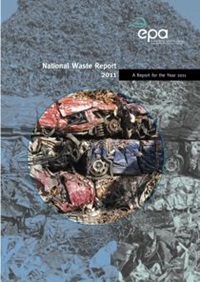
Waste figures released by the Environmental Protection Agency (EPA) show that Ireland’s municipal solid waste generation has decreased by 17% since it peaked in 2007, largely as the result of the recession and a decline in personal consumption. Ireland now produces less household waste per capita than the EU average and is recycling 40% of its municipal waste. Ireland is also achieving all its EU waste recovery targets with the exception of End of Life Vehicle recovery.
The main findings of the report showed that in 2011:
- Municipal solid waste generation in Ireland has decreased by 17% since it peaked in 2007.
- There was a 5% increase in municipal waste recovery since 2010, to 47%.
- The recycling rate for municipal waste is now equivalent to the EU norms, at (40%).
- The bulk of municipal waste recovered, 73%, is exported for recovery.
- The majority of municipal waste, 53%, is disposed of to landfill – though this continues to decrease year on year.
- The tonnage of refuse derived fuel (RDF) used as a fuel at cement kilns and incinerators in Ireland and abroad increased by 68%.
- Ireland has surpassed the 2011 EU packaging recovery target of 60%, with a 79% recovery rate in 2011.
- Household WEEE collection amounted to 7.6 kg per person, almost double the 4 kg per person EU target.
- There was an 83% decrease in construction and demolition waste collected since 2007.
- There was a 21% increase in household organic waste collected since 2010.
Commenting on the figures Dr Jonathan Derham, EPA said: “Ireland is well advanced towards achievement of all of its EU obligations across a broad range of waste legislation, in particular in relation to recovery and recycling. In fact, a recent European Environment Agency report showed that Ireland was one of the countries in Europe with the fastest growing recycling rates. However, Ireland continues to show a substantial reliance on recovery of municipal waste abroad.
“In addition, some future targets remain at risk of not being met. Ireland’s continued reliance on landfill means that we are at risk of not reaching strict biodegradable waste diversion targets by 2016. Also, with higher End of Life Vehicle (ELV) targets coming into effect from January 2015, urgent action is needed to increase reuse, recovery and recycling of ELV materials.”
Dr Derham continued: “We have to decouple waste generation from economic growth through ensuring that waste prevention and resource efficiency remains at the core of targeted national policy and measures, so that when economic recovery happens there is not an associated increase in waste to be managed.
Householders, communities and businesses all need to play their part by engaging more in resource efficient behaviours. The EPA has a range of support services for businesses and consumers to help them improve competitiveness and save money through waste prevention and resource efficiency.”
Notes
Municipal waste (MSW) means household waste as well as commercial and other waste that, because of its nature or composition, is similar to household waste. It excludes municipal sludges and effluents. In the context of this report municipal waste consists of three main elements – household, commercial (including non-process industrial waste), and street cleansing waste (street sweepings, street bins and municipal parks and cemeteries maintenance waste, litter campaign material).
Recovery means any operation the principal result of which is waste serving a useful purpose by replacing other materials which would otherwise have been used to fulfil a particular function, or waste being prepared to fulfill that function, in the plant or in the wider economy. Annex II of the Waste Framework Directive (2008/98/EC) sets out a non-exhaustive list of recovery operations, which includes material recovery (i.e. recycling), energy recovery (i.e. use a fuel (other than in direct incineration) or other means to generate energy) and biological recovery (eg composting).
Recycling means any recovery operation by which waste materials are reprocessed into products, materials or substances whether for the original or other purposes. It includes the reprocessing of organic material but does not include energy recovery and the reprocessing into materials that are to be used as fuels or for backfilling operations.
Source: Envirocentre – EPA Report Shows that Recycling and Recovery Rates are Improving





